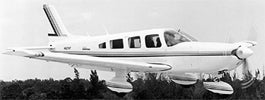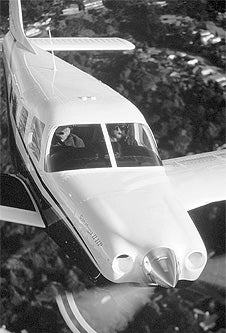 Piper Saratoga  Piper Turbo Saratoga  Piper Saratoga SP |
 Piper Saratoga II HP |
| STANDARD DATA: (SP) Seats 6. Gross wt. 3,600. Empty wt. 1,986. Fuel capacity 107. Engine 300-hp Lycoming. PERFORMANCE: Top mph 189. Cruise mph 183. Stall mph 66. Initial climb rate 1,010. Ceiling 16,700. Range 995. Takeoff distance (50′) 1,759 (two-blade), 1,573 (three-blade). Landing distance (50′) 1,612. STANDARD DATA: (Turbo SP) Seats 6. Gross wt. 3,600. Empty wt. 2,073. Fuel capacity 107. Engine 300-hp turbocharged Lycoming. STANDARD DATA: (Saratoga) Seats 6. Gross wt. 3,600. Empty wt. 1,920. Fuel capacity 107. Engine 300-hp Lycoming. STANDARD DATA: (Turbo) Seats 6. Gross wt. 3,600. Empty wt. 2,000. Fuel capacity 107. Engine 300-hp turbocharged Lycoming. |
|
In order to organize and improve its “workhorse” lineup, Piper introduced the Saratoga models in 1980 to replace the Cherokee Six and Lance models. The Saratoga brand actually applies to four separate airplanes. Beginning with the junior model in the brood, we have the basic Saratoga, a six-place fixed-gear 300-hp version. Next is the Saratoga SP, which is everything the basic Saratoga is except that the feet tuck away in flight. For the rare-air set, there is the turbocharged version of the stiff-legged model, designated the Turbo Saratoga. With retractable gear, the high-sky version becomes the Saratoga SP. Possibly the most significant aerodynamic change is the move from the stubby airfoil of the Cherokee line to a state-of-the-art semi-tapered wing that is gracefully slender and powerfully long.
After all the hoopla that surrounded the introduction of the T-tail on the Lance, returning to the full span stabilator was a move for which a variety of reasons were offered. According to Piper, the new wing is so aerodynamically efficient and docile that it simply doesn’t need the T-tail to help, and since the T-tail is inherently more expensive to produce, there was no need to keep it. An optional three-blade propeller for all models reduces cabin noise, delivers peak performance on takeoff and climb out, and offers better clearance when taxiing. Double rear doors make loading easy and helps owners take advantage of the Saratoga’s substantial cargo capacity.
While the designation SP basically means retractable gear, it literally translates to “Special Performance.” The aerodynamic profile is exceptionally clean by combining tuck-away gear with semi-tapered wings, which cut parasite drag to a minimum, and flush riveting on the leading edge. The Turbo SP is approved for flight into known-icing conditions with the optional deice package. The Saratoga provides a remarkably quiet and comfortable environment, closer to that usually associated with large multi-engine aircraft.
In 1994, the ’SP’ changed to ’HP’ when New Piper introduced the Saratoga II HP (high performance), in both normally aspirated and turbocharged models. The basic airframe remains unchanged, however interiors and avionics have remained continuously upgraded.



